In large software projects, it is important to design code so that it is easy to maintain and certain functionalities can be found quickly. In addition, it should also have a structure that makes it possible to use a certain function several times in a large code instead of rewriting it each time. Object-oriented programming is one of the best methods for organizing and simply structuring code.
In the Python programming language, objects and classes are used for this purpose, which significantly simplify the structure of a software project and structure the code better. In this article, we look at the syntax of these components and deal with the basic properties through to more complex processes such as inheritance or polymorphism. Using understandable code examples, we show how easy it can be to incorporate these ideas into code to make it less complex and better structured.
Why do you need Classes and Objects?
In increasingly complex software projects, which often require teamwork, it is important to structure the code so that it is easy to understand, easy to maintain, and runs efficiently. With the help of so-called object-oriented programming, supported in the Python programming language, among others, complex applications can be divided into smaller, logically connected parts that can be worked on independently. As long as the inputs and outputs of a function remain identical, the code fits seamlessly into the other elements and the algorithm can be easily modified.
In Python, classes and objects provide a solid foundation that can be used for object-oriented programming. The class can be thought of as a blueprint that defines the properties and behavior of an object. The object, on the other hand, is a concrete instance, i.e. an elaboration of this blueprint. The class “car”, for example, includes properties such as the color, the number of doors, or the power of the engine. A specific car, on the other hand, is an object that has the color red, four doors, and an engine power of 200 hp.
Object-oriented programming offers various advantages, such as
- Reusability: Once a class has been defined, it can be used as often as required within the code and new attributes can also be added to it.
- Modularity: By dividing the code into different objects, these can also be tested and edited independently of each other. This simplifies further development, for example, as they can be distributed to different team members.
- Better maintainability: Even with extensions, the code can still be easily maintained and can even be quickly understood by new employees, as predefined structures and relationships exist.
- Extensibility: With the help of inheritance, new code can build on existing classes without having to change the original code.
Classes in Python
A class in Python is a user-defined structure that is used to create and instantiate specific objects. All functionalities and methods that can be executed with this data are stored centrally in it. In the following sections, we explain the basic syntax for creating and using classes.
How do you create a class?
To create a class in Python, you use the word class before the name of the class. This name is typically defined in the so-called camel case notation, which is characterized by the fact that consecutive words are strung together without spaces or underscores and each new word must begin with a capital letter. The following letters can be either upper or lower case. The first word can either begin with a lowercase letter, as in “iPhone”, for example, in which case it is referred to as lowerCaseCamel. If, on the other hand, the first word also begins with a capital letter, as in “PlayStation”, it is referred to as UpperCamelCase.
The definition then ends after the name of the class with a colon, whereupon the next line starts with an indentation and contains the actual logic. In this simple case, we define nothing more than pass, so that the class itself does not execute any code.

Normally, a class contains various attributes that define the properties and make the differences between the objects. To do this, we need the __init__ structure, which we will look at in more detail in the next section.
What are Attributes and the __init__ structure method?
The __init__ method is a special method in Python that is called when an object is instantiated from a class. We will look at exactly what this means at a later stage. At this point, it is only important to understand that __init__ assigns various attributes to a class and thus defines initial values. For example, a person can have a name and an age, which are represented as attributes as follows:

At first glance, this may seem confusing, as you would expect that concrete values have already been assigned here and instead only name and age have been stored. We should therefore remind ourselves that we use classes to obtain reusable code and to modularize it. These lines mean that you can use the Person class to create different persons with different names. To do this, you call the class and define two concrete parameters for this specific person in round brackets. The argument self serves as a reference to the current object and enables access to the attributes of the object. Using this logic, we can then define the person, Alice, for example.

The specific properties can be queried by calling up the object name and the attribute separated by a dot. This gives us the name or age, for example. Such attributes, which are defined within the __init__ constructor, are called instance attributes, as they differ from instance to instance. On the other hand, there are the class attributes, which apply to a complete class and therefore also to each instance. It can be called via the class name or a special instance and can also be changed via this.

To be able to work with these attributes or perform certain calculations, so-called methods are required.
What are the Methods?
Methods are functions that are defined within a class to determine the behavior of the objects and to be able to work with the attributes. They not only have access to the instance attributes but can also change and overwrite them. The special feature of each method is that the first argument must always be self to access the corresponding object from which it is called.

The introduce() method, for example, accesses the two attributes age and name and returns them as a character string. The age_in_days() method goes even further and changes the attribute of the object when it is called. After the call, the age is then no longer stored in years, but in days.
Objects in Python
Objects in Python are instances of a class that contain specific attributes and are stored in a variable. When working with objects, it is particularly important to know how to create them, how individual attributes can be retrieved and overwritten, and how to use the methods.
Creating Objects
As we have already seen in the previous sections, we can create an object by defining a class and then calling it and passing the concrete attributes for the object in round brackets, which the __init__ constructor requires. This instantiates the object and we can work with the instance in the subsequent code.

Accessing Attributes and Methods
Once an object has been instantiated, you can access the attributes and methods in it using the operator. To do this, you use the name of the object, a dot, and then the name of an attribute or method. However, these can not only be read but also overwritten or changed to modify the object.
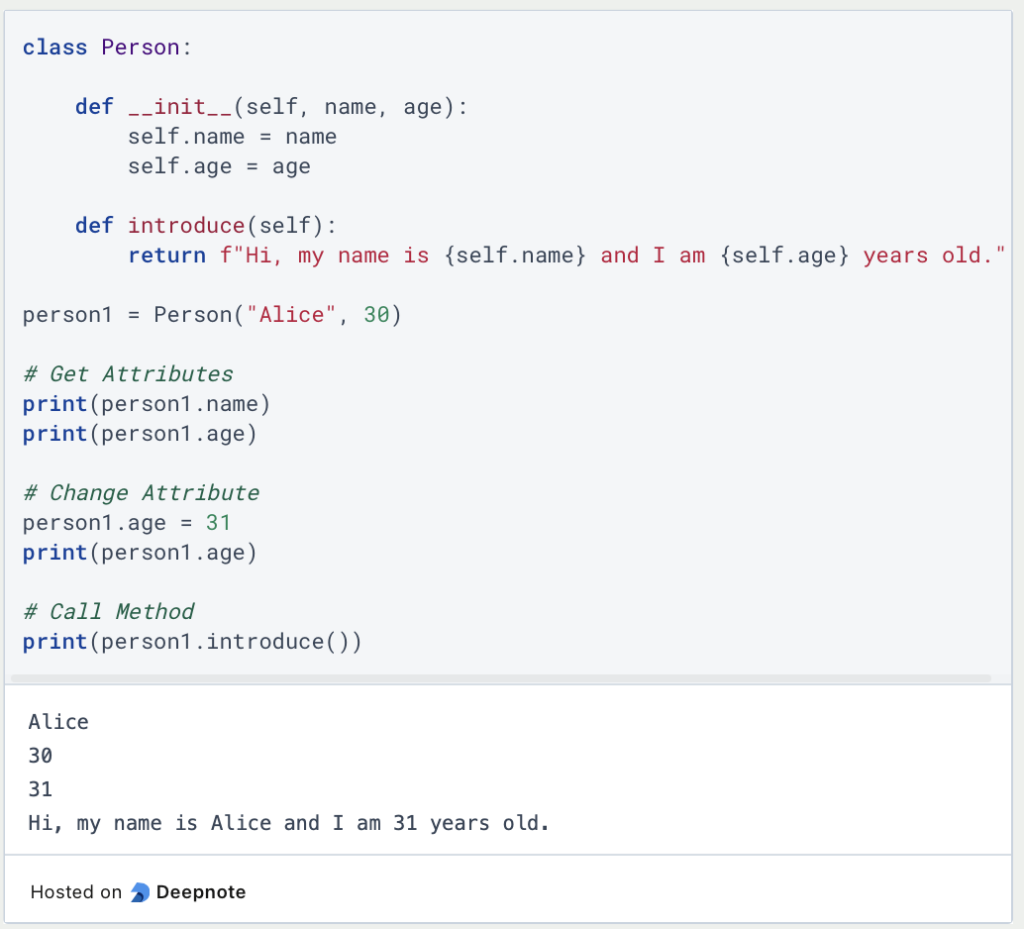
In the example above, we first retrieved the attributes of person1 and then changed the age to 31 and retrieved it again to see that the change worked. Finally, the introduce() method was called to introduce person1.
Working with multiple Objects
Many different objects can be created from one class, which usually differ in that they have different attributes. It is important here that unique variable names are used for the instances to ensure that they are separated from each other and do not overwrite each other.
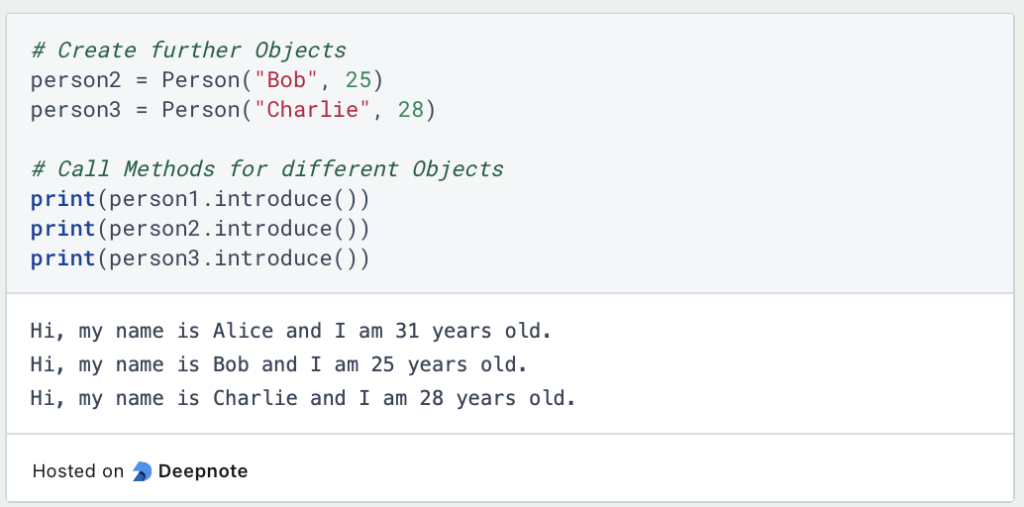
In this example, a separate object instance is created for each person, with different attributes. Of course, it would also be possible to have two instances that have the same attributes, for example, if two people happen to have the same name and the same age. It is then important to define the variable names in such a way that the two objects can be separated from each other.
What are Method Types in Classes?
In Python, different types of methods can be used within a class and fulfill specific tasks depending on the application. Each of these methods offers different advantages, depending on whether they affect the entire class, a single instance, or both independently.
Instance Methods
The instance methods are the most frequently used and have already been presented several times in this article. These are functions that refer to a specific object of the class and perform calculations using the specific attributes, for example. They are characterized by the fact that the first parameter of this method is self, which enables the method to access and process attributes and other methods of the object.
The introduce() method is a classic example of an instance method that uses the specific attributes for name and age to form a character string.

Class methods (@classmethod)
Class methods refer to the class as a whole and not to individual instances within it. They are mainly used for logic that should apply to all instances of a class, e.g. rules that apply when new instances are created. Class methods are started with the decorator @classmethod and have cls as the first parameter, which represents the class itself. A class method can be called in the same way as other types of methods, separated by a dot.

The class method from_birth_year() allows new objects to be created even if the specific age is not known, but only the year of birth. The method then simply calculates the age and sets it as an attribute for the object. In this way, the method offers an alternative initialization option.
Static Methods (@staticmethod)
Static methods differ from the previous two types in that they are independent of specific objects or classes and therefore do not require the self or cls parameter. They are suitable for auxiliary functions that are only loosely connected to the class and do not require any attributes or other methods, i.e. they are self-contained.

In this example, we add the static method add(), which can add any two numerical parameters together and therefore does not require access to other parameters or methods.
How does Inheritance work?
A central concept of object-oriented programming is inheritance, which allows new classes to build on existing classes and adopt their attributes and methods. This significantly increases the reusability and extensibility of code, as specialized functionalities do not have to be redefined each time.
The base class is the class from which other classes can inherit attributes and methods. It can be defined normally and does not contain any special functionalities. In our example, we want to create a base class for vehicles and then derive new classes for different vehicle types, such as cars or motorcycles, from it. To do this, we first define the base class.

The derived class Car is defined in such a way that it inherits all methods and attributes from Vehicle. For this purpose, the base class, i.e. Vehicle, is defined in brackets during definition. During initialization, the super() function is used to indicate that the attributes are taken from the base class, thereby avoiding the need to redefine them. In addition, super() can be used to access methods of the base class, such as the output .description(), which can then be extended by further attributes in the derived class.

In this example, a method override also takes place by overwriting the .description() method from the base class and extending it with additional attributes from the Car class. This functionality is particularly useful if the method from the base class only provides a general framework and more specialized functionalities are then required in the derived class.
Inheritance allows various code components to be reused and extended. For this purpose, a very general base class is defined on which other, derived classes can then build and add further attributes or modify existing methods.
What is Polymorphism?
Polymorphism is another concept in object-oriented programming that expresses the fact that different objects from different classes can be addressed and processed via a common interface. This means that a method with the same name can be implemented differently for different classes and can still be called using the identical name.
In practice, two different concepts are used for this:
- Method Overloading: In contrast to other programming languages, Python does not support classic method overloading. However, with the help of flexible parameter lists in methods, for example by using
*args, comparable functionalities can be achieved. This allows methods to have the same name and still accept different parameters, depending on what the object requires. - Method Overriding: This is the more common form in the application and describes the procedure when a derived class overrides a method of the base class to cause a more specific behavior, as we saw in the last section for
.description(). This allows the same method to be customized depending on the object type.
In practice, polymorphism is mainly used when a function needs to use objects from different classes without having to know the exact details. In the following example, all classes contain a speak() method, which can have different results depending on the specific class. However, the animal_speaks() function does not need to know these differences, as it can simply call the method via a central interface and automatically has a different output depending on which object it receives.

Polymorphism makes it possible to design code and functions flexibly and efficiently regardless of the object type and to work via a standardized interface.
What Special Methods are there?
Special methods, or magic methods, are methods that provide special functions in Python by allowing classes to use certain operators and functions. They begin and end with double underscores (“__”), which is why they are also called Dunder methods (an abbreviation for double under). These methods enable intuitive interaction with the methods and thus facilitate the creation of user-defined classes.
Some magic methods that are frequently used are presented in the following section:
__str__: This method is called when a readable and user-friendly representation of an object is required. For example, it can be used to display a clear representation of the attributes. If the object is then called withprint(), what was defined in__str__is displayed.
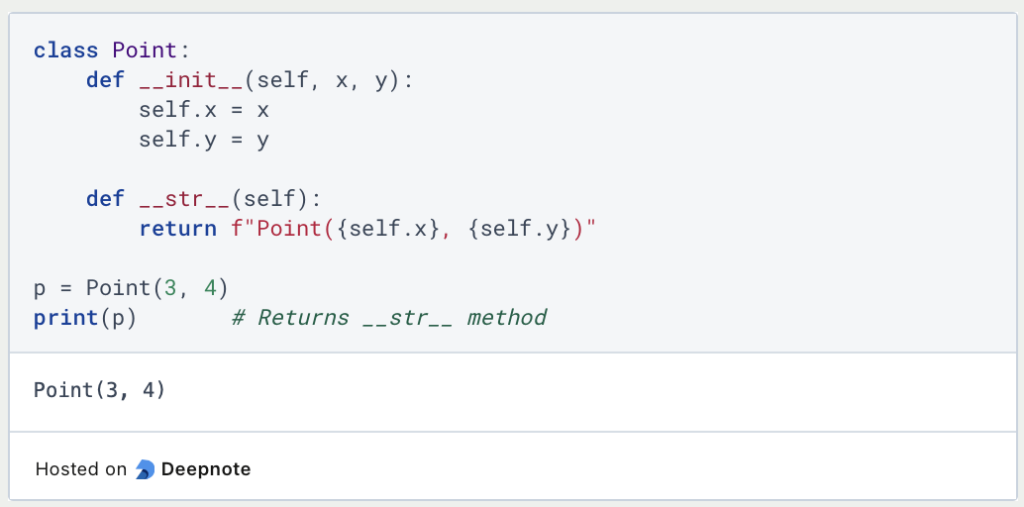
__repr__: This method is similar to__str__and should be used to return a representation of the object that is as distinctive as possible, which in the best case could be used to recreate the object. It is often used when you want to display an object directly in the console. It can be easily called outside the class usingrepr().
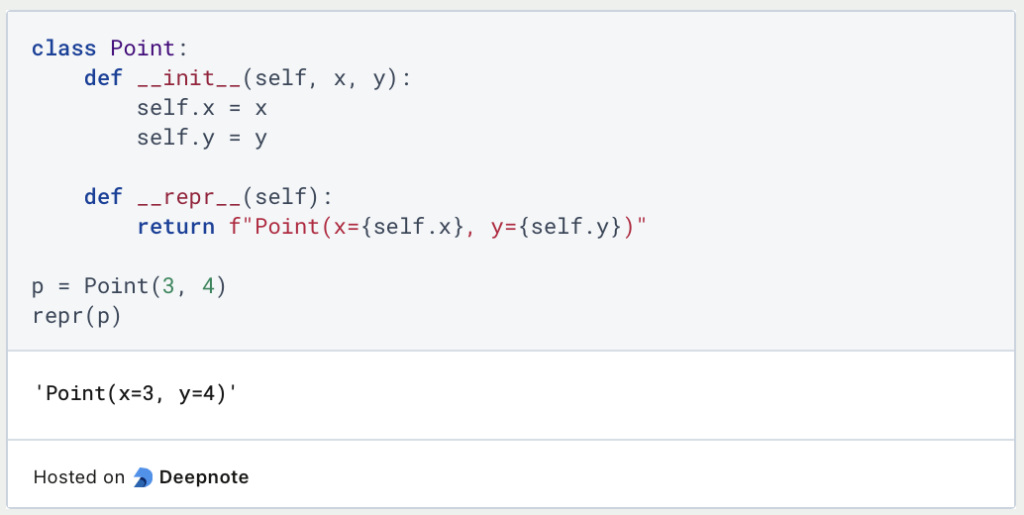
__add__: This method can be used to overload the+operator so that a new method of addition is defined for two objects of the class. If two objects of the Point class are added, for example, the two x-coordinates and the two y-coordinates should be added together. If the+operator is then called for two objects, the addition takes place as defined. However, if two other objects that do not originate from the class are added with+, the addition takes place as normal.
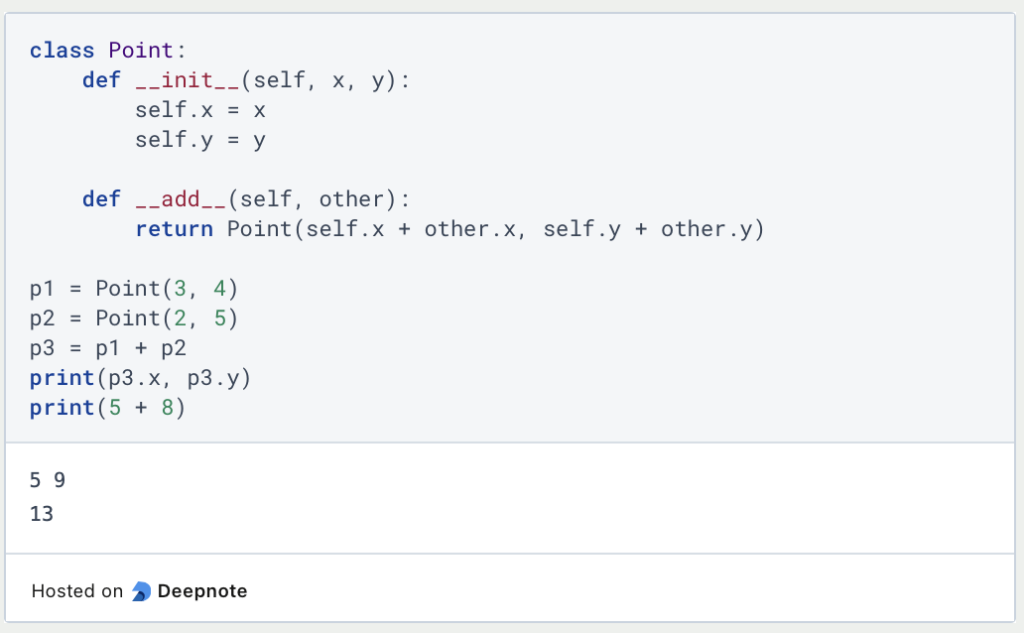
__eq__: This method overloads the==operator and defines how two objects of the class are to be compared with each other. This can therefore be used to check whether two objects are identical or not. As with__add__, however, this does not affect comparisons between two objects that are not instances of the class.
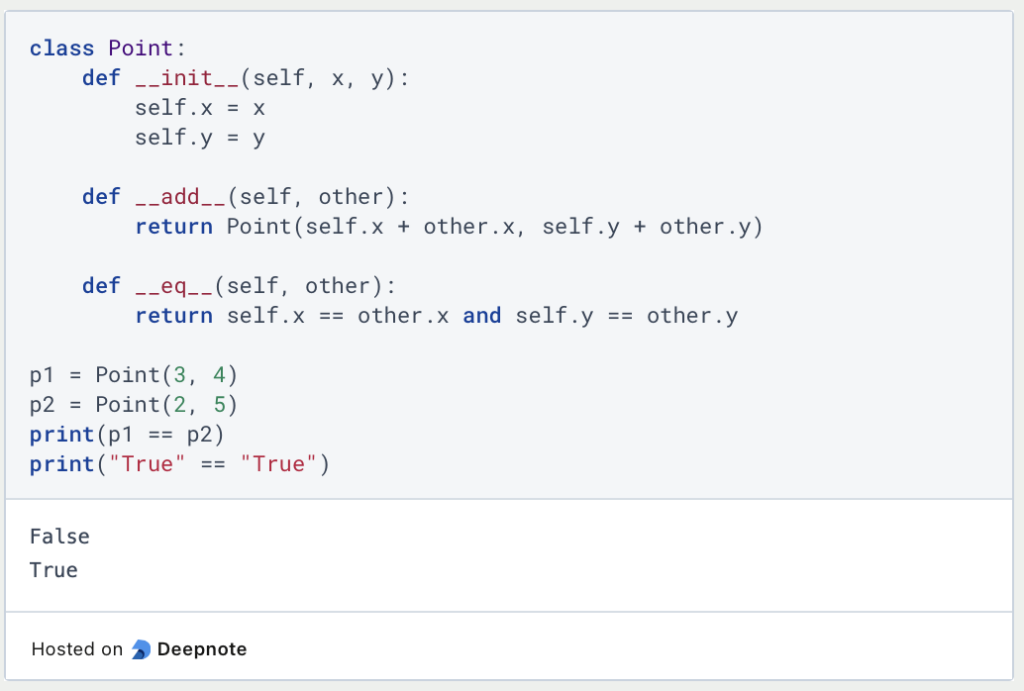
__len__: This magic method allows you to define your logic for determining the length of an object of the class. In our example of a point in two-dimensional space, for example, the length can be defined so that it returns the length of the vector that leads from the origin to this point. The Pythagorean theorem is stored for this purpose. As thelen()method can only return integers, we have to convert the length into an integer accordingly and thus lose some precision.

The special methods make it possible to handle objects and classes more intuitively by overloading common operators such as + or len() with new functionalities that only apply to the instances of the class and otherwise retain their usual functionality.
This is what you should take with you
- Object-oriented programming is a central concept that leads to better-structured and reusable code.
- In Python, objects and classes are used to implement object-oriented programming.
- Classes are general concepts and blueprints that serve as the basis for instantiating special objects, which then have specific attributes.
- Methods, on the other hand, are special functionalities that perform calculations within the class. A distinction is made between instance methods, which use specific attributes of the object, class methods, which are defined for an entire class, and static methods, which can act completely independently of the class.
- Inheritance makes it possible for classes to adopt certain methods and attributes from a base class without having to redefine them.
- With the help of special methods, working with classes can be made much more intuitive, as common operators and their functionality are overloaded for objects of a class.
Python Programming Basics: Learn it from scratch!
Master Python Programming Basics with our guide. Learn more about syntax, data types, control structures, and more. Start coding today!
What are Python Variables?
Dive into Python Variables: Explore data storage, dynamic typing, scoping, and best practices for efficient and readable code.
What is Jenkins?
Mastering Jenkins: Streamline DevOps with Powerful Automation. Learn CI/CD Concepts & Boost Software Delivery.
What are Conditional Statements in Python?
Learn how to use conditional statements in Python. Understand if-else, nested if, and elif statements for efficient programming.
What is XOR?
Explore XOR: The Exclusive OR operator's role in logic, encryption, math, AI, and technology.
How can you do Python Exception Handling?
Unlocking the Art of Python Exception Handling: Best Practices, Tips, and Key Differences Between Python 2 and Python 3.
Other Articles on the Topic of Classes and Objects in Python
This link will get you to my Deepnote App where you can find all the code that I used in this article and can run it yourself.

Niklas Lang
I have been working as a machine learning engineer and software developer since 2020 and am passionate about the world of data, algorithms and software development. In addition to my work in the field, I teach at several German universities, including the IU International University of Applied Sciences and the Baden-Württemberg Cooperative State University, in the fields of data science, mathematics and business analytics.
My goal is to present complex topics such as statistics and machine learning in a way that makes them not only understandable, but also exciting and tangible. I combine practical experience from industry with sound theoretical foundations to prepare my students in the best possible way for the challenges of the data world.





